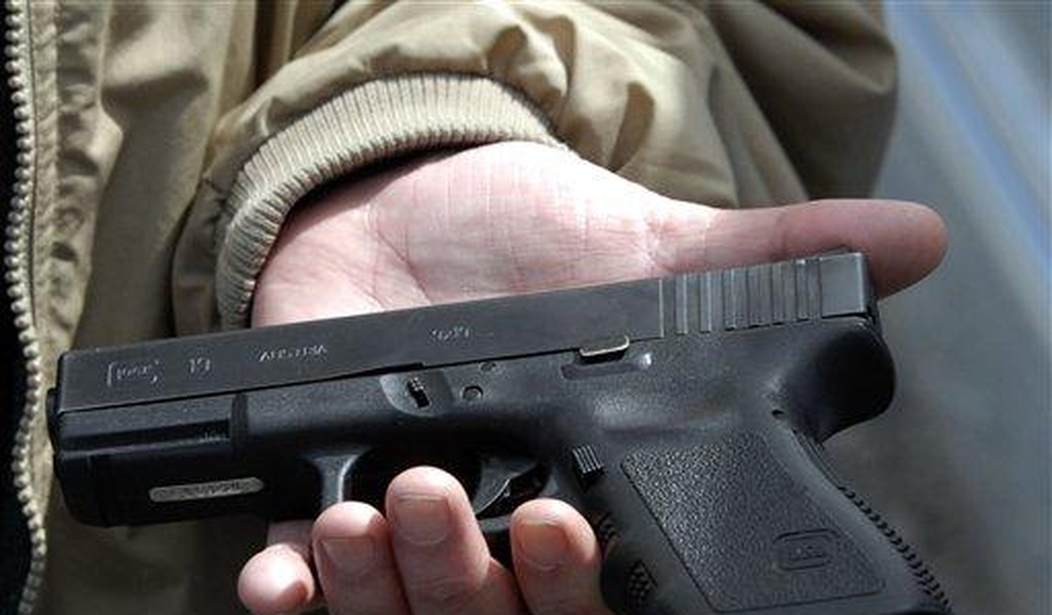So-called Glock switches are a device you can attach to a Glock and turn it into a fully-automatic firearm. In Chicago, they’re turning up more and more often. They’re illegal as hell, at least when applied to an actual firearm–my understanding is they were designed for airsoft guns, which wouldn’t run afoul of any law I’m aware of–but they’re here nonetheless.
And the problem for the Windy City is likely only to get worse.
The firearm used was a Glock 19 handgun that had been converted to an illegal high-capacity machine gun with a device known as an auto sear, a square device about the size of a thumbnail. It’s known on the street as a “switch” that turns the gun from a semi-automatic to an automatic weapon.
The Glock came with an extended magazine, making the weapon even deadlier. The magazine held 34 rounds, according to court records. Sanders told authorities he bought the gun in Indiana and the switch for less than $25.
Despite a longstanding federal ban on auto sears, and a ban on extended magazines in Chicago and surrounding Cook County, the number of guns with the illegal attachments being seized by the city’s police department has surged in the last several years, an investigation by the Chicago Sun-Times, WBEZ and NPR has found.
The investigation found that:
- The number of extended magazines — those with more than 10 rounds — recovered by Chicago police more than doubled from 2018 to last year, up from 459 to 924, records show.
- Chicago police have recovered extended magazines in at least 13 mass shootings since 2018. Eleven of the 13 were in the last two years.
- The number of auto sear-equipped handguns seized by Chicago police skyrocketed from zero in 2018 to 355 last year, leading federal authorities to declare that Chicago has one of the worst switch problems in the country.
- Since 2018, Cook County prosecutions of auto sears and extended magazines — machine-gun prosecutions — increased from six in 2018 to 201 last year.
Now, when you look at the total amount of violent crime in Chicago, this may look like relatively small potatoes, but it’s the growth that represents an issue.
In four years, we’re seeing an order of magnitude or of an issue with these switches, and as the article notes, they’re already illegal.
That won’t stop many from trying to pass further restrictions, but these switches also represent an example of why that’s a lost cause.
See, while many of these are imported from China, they can also be made with a 3D printer. The files are all over the internet and, frankly, as the man in the movie said, “You can’t stop the signal.”
“But if we ban the magazines, the lethality of these full-auto Glocks will be blunted,” some might argue, and to be absolutely fair, there’s a hint of truth to that. Rather than spraying 30 or more rounds at a time, you’re looking at 15 rounds and then a reload. Since it’s unlikely your average gangbanger has bothered to practice reloads–and let’s be honest, they’re shooting full auto because they don’t practice shooting and are instead practicing “accuracy by volume”–that means the delay will give people a chance to run for safety.
The problem with that thinking, though, is that magazines can be made via a 3D printer as well. That includes the evil “high capacity” magazines like these. You’re not going to stop bad guys from getting them because someone will be happy to make and sell them to them.
Restrictions just mean law-abiding citizens won’t have them. That’s all it will mean.
Now, here’s what I’m not saying.
I’m not saying there’s nothing that can be done, that cities like Chicago are just going to have to learn to live with Glock switches and gangbangers shooting up entire neighborhoods in a matter of seconds. They shouldn’t have to and they don’t.
What I’m saying, though, is that there needs to be another path.
This idea of restricting the weapons started with the mob in Chicago and where has that gotten us? Violent crime has ebbed and flowed since then. Note this chart:

Note how the homicide rate climbed and climbed, then dropped after Prohibition ended, only to climb back up.
There weren’t really any new technologies that changed gun access during that time. In fact, that surge in the 1970s followed the passage of the Gun Control Act of 1969, which makes no sense if you think gun control is the answer.
That ebb and flow, though, illustrates that there are factors that can reduce violent crime without restricting people’s right to keep and bear arms.
Folks in Chicago shouldn’t have to live like this. They’ll continue to do so, however, until people wake up and recognize that the issue isn’t guns, but people.








